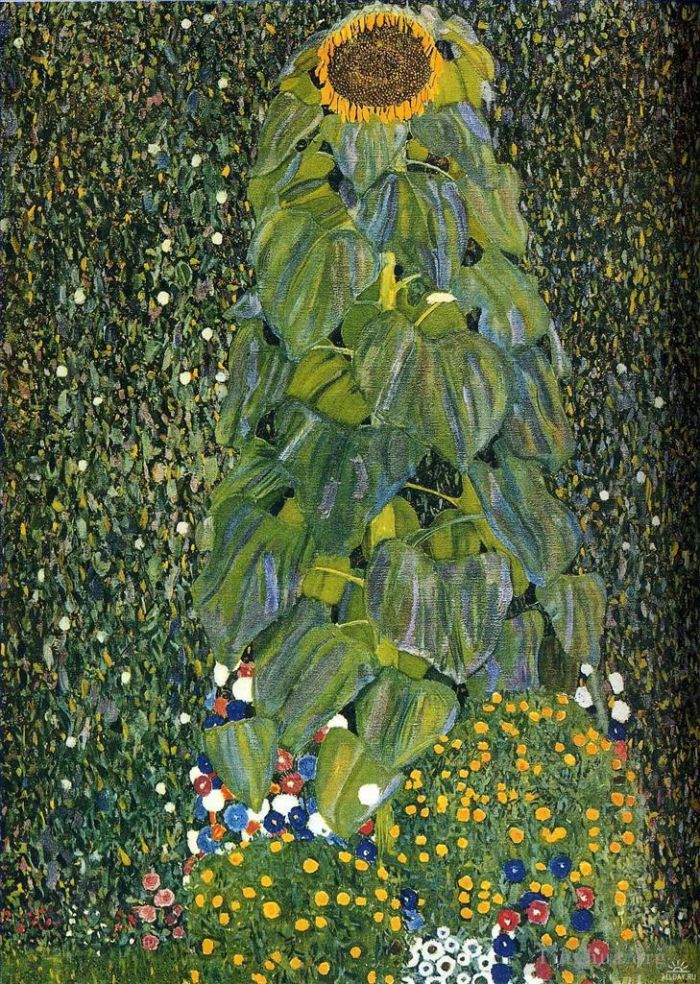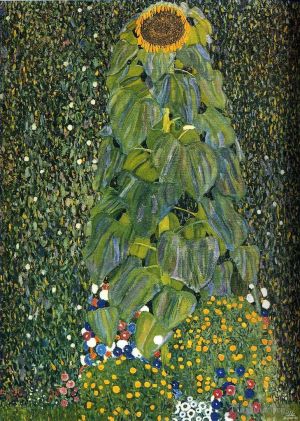The Sunflower
Gustave Klimt
- Price: Price on Request
- Art Type: Oil Painting
- Size:
- English Comments: 0
- International Comments: 0
- Creating Date:
- Introduction and Works of Gustave Klimt >>
Keywords:
Sunflower
Work Overview
- The Sunflower
Gustav Klimt
Date: 1906 - 1907
Style: Art Nouveau (Modern)
Period: Golden phase
Genre: landscape
Media: oil, canvas
Dimensions: 110 x 110 cm
Location: Private Collection
During the early 20th Century, Klimt was a member of Vienna Secession, which was a radical Avant Garde artistic establishment that was based in Austria. Other artists of the time included Auchentaller and Fabiani.
The symbol that was used to represent the group was that of Pallas Athena, who was the Greek goddess of wisdom.
Klimt's art was incredibly decorative and very different from the art that was being produced in Europe at that time. His paintings very much resembled the art that was being painted in France, within the Art Nouveau movement.
The Sunflower represents the very heart of this movement. What we see is an incredibly tall sunflower with a thick, luscious, green stalk with many leaves.
Bright flowers can be seen poking through the grass underneath, that help to both define and give depth to this majestic sunflower.
It was during this time that Klimt painted gold leaves onto his canvases, so as to enrich the image, and this can be clearly seen in this painting. Indeed, the painting appears to sparkle and almost appears to be not of this world, but that which is within a magical realm.
The image has been painted in a similar way to his famous painting, Eden. There is also a distinct similarity to his famous painting, The Kiss, as the golden leaves seem to entwine and embrace, in a similar way to the lovers in the now iconic image.
The Sunflower is presented in an upright form, almost as if it is a triangle. This also resembles the image of the lovers in The Kiss. Another theory within the art world, is that the image of the sunflower resembles that of Emilie Floge, an iconic and world renowned dress maker who was a close friend to Klimt.
The intricate leaves and flowers that are present represent her dress, while the flower head itself represents her face. The image is dominated with various hues of blues, greens and yellows.
The leaves have been painted with a slightly blue hue, which helps to add definition and a majestic quality, while the background has been subjected to white splashes of colour, that he used to illuminate the image and add depth to an otherwise dark background.
What this darkened background manages to achieve is that of drawing the eye to the towering sunflower. During this period in Klimt's carer, he was working closely with his friend and mentor, Van Gogh, and there are many comparisons to be made to his Sunflowers painting.
Possibly this is due to the blue tones of the image, as well as the overall feeling of sadness when we look at this regal flower. Perhaps this is due to the fact that the flower appears to be all alone.
Klimt was well known for his paintings of nature, and primarily those of tress and flowers, and although this painting is of nature, it differs from his previous creations.
This is possibly because we are observing an image that is natural, as the scene has not been influenced by human hands. The almost ethereal quality, that is represented with the golden leaves and purple tones, helps to create the natural image.
The flower is left in its natural environment. It has not been cut and arranged in a bowl, as so many paintings depicted at that time. What we observe is the natural scene in all of its splendour.
The Sunflower is unusual in Klimt's paintings of trees and flowers in that there seems to be a certain anthropomorphic element. Once immediately thinks of Van Gogh's sunflowers, which were almost self-portraits. However, Klimt's flowers are still in situ, growing in the garden, while Van Gogh's have been picked and arranged in a vase. Th sunflower paintings by Vincent van Gogh are still lifes, whereas Klimt's images are details of the landscape. The shape and leaves in The Sunflower is remarkably like the form of the lovers in The Kiss. The two works were exhibited for the first time in 1908 at the Art Show Vienna.
Unlike the earlier landscapes from around 1898 to 1902, the painting of sunflowers are no longer concerned with mood; rather, Klimt is fascinated in a more objective way by the organic life that simply exists, independent of human intervention. The geometrical composition of his painting is no longer merely used for decorative effect, but to reinforce the artist's deatched observation of the scene while delighting in the opulence and abundance of nature.
- Copyright Statement:
All the reproduction of any forms about this work unauthorized by Singing Palette including images, texts and so on will be deemed to be violating the Copyright Laws.
To cite this webpage, please link back here.
- >> English Comments
- >> Chinese Comments
- >> French Comments
- >> German Comments
- >>Report
- Woman in Gold
- Portrait of Adele Bloch-Bauer I
- Stiller Weiherim Schlobparkvon Kammer
- The Beethoven Frieze 1902
- Water Snakes II(Water Serpents II)
- Malcesine am Gardasee (Malcesine on Lake Garda)
- Portrait of Adele Bloch-Bauer II
- Buchenhain
- Portrat der Fritza Riedler
- Gartenmit Huhnernin StAgatha
- Sonja Knips
- Nuda Veritas
- Avenue of Schloss Kammer Park
- Bauernhausin Oberosterreich
- Bildnis Fritza Riedler 1906
- Judith
- Die Musik
- Minerva or Pallas Athena
- The Kiss
- Houses at Unterach on the Attersee
- Portrait of a Lady
- Die Liebe
- Two Girls With An Oleander
- Fable
- Gold fish
- Farmhouse with Birch Trees
- Design for the Stocletfries
- Church in Unterach on the Attersee (Church in Unterach on Lake Attersee)
- Gartenmit SonnenblumenaufdemLande
- Chruch in Cassone
- Pine Forest II
- University of Vienna Ceiling Paintings
- Mohnfeld
- Fredericke Maria Beer
- Apple Tree II
- Farm Garden with Crucifix
- Portrateiner Dame
- The Virgin (The Maiden)
- Landscape Garden Meadow in Flower
- Dame mit Cape 1897
- Beech Grove I (Beech Forest I)
- The Girl friends (The Lesbians)
- Lady with Fan 2
- Der Beethovenfries Wandgemaldeim Sezessionshausin Wienheuteosterr 2
- Garden with Roosters (Garden Path with Chickens)
- Water Snakes (Watersnakes I or Water Serpents I)
- Danae (Danaë)
- Lady with Fan
- Apple Tree I
- Portrait of Hermine Gallia
- Portrait of a Lady 3
- The Virgins
- The Big Poplar II
- Baby
- The Dancer
- Flower Garden (Farm Garden)
- The Sunflower
- Schlob Kammeram Attersee
- Portratder Friederike Maria Beer
- Love 1895
- Teas in Klimt Style
- Lakeside with Birch Trees
- Reclining Nude Lying on Her Stomach and Facing Right
- Portrait Of Eugenia Primavesi
- Die Grobe Pappeloder Aufziehendes Gewitter
- Portrat der Margaret Stonborough Wittgenstein
- Fir Forest I
- Park of Schönbrunn (Schönbrunn Palace Garden)
- Water Castle
- Death and Life
- Schubert at the piano I
- Farmhouse in Upper Austria
- Baby 3
- Amalie Zuckerkandl
- Portrat der Maria Munk
- Portrait of a Girl
- Emilie Floge Aged 17
- Portratder Baroness Elisabeth BachofenEcht
- Italian horticultural landscape
- Portrait of Gertha Felssovanyi
- Hope I
- Blooming field
- The Beethoven Frieze The Longing for Happiness Finds Repose in Poetry
- The House of Guardaboschi
- Schloss Kammer on the Attersee IV
- Fruit Trees
- Mada Primavesi c 1912
- The Women Friends
- Mother with Children
- Portrait of Serena Lederer
- Roses under the Trees
- Bildnis Margaret Stonborough Wittgenstein 1905
- Bewegte Wasser
- Lady with Hat and Featherboa
- After the Rain Garden with Chickens in St Agatha
- Country House by the Attersee
- The Beethoven Frieze The Hostile Powers Far Wall
- Portrait of Emilie Floge 2
- Portrait of Marie Breunig
- Untitled landscape
- Derschwarze Hut
- The Swamp
- Portrait of Helene Klimt
- Der Beethovenfries Wandgemaldeim Sezessionshausin Wienheuteosterr 4
- Portrait of Emilie Floge
- Portratdes Schauspielers Josef Lewin skyals Carlos
- Baby 2
- Judith and the Head of Holofernes
- Mulhersentada
- The Three Ages of Woman
- Adam and Eva
- Horticultural landscape with a hilltop
- Hope II
- Sapho
- Kuheim Stall
- Portrait of Baroness Elisabeth Bachofen Echt red
- The Tree of Life Stoclet Frieze
- Island in the Attersee
- Farm Houses with Birch Trees
- Schloss Kammer am Attersee II
- Das Hausvon Guardaboschi
- Girl with Long Hair with a sketch for Nude Veritas
- Fishblood
- Allegory of Sculpture
- Idylle 1884
- Januar









 Singing Palette
Singing Palette